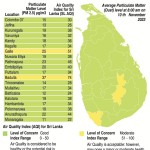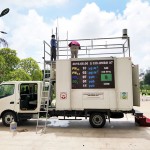News
Sri Lanka on alert as Delhi air quality raises concerns
View(s):As the air quality of certain northern cities in India moves towards hazardous levels, concerns are growing about transboundary air pollution affecting Sri Lanka’s air quality.
Environment Studies Director of the National Building Research Organization (NBRO) Sarath Pemasiri told the Sunday Times that every year concerns about air pollution rise between November and March as polluted air flows into the country (transboundary air pollution).
A senior scientist, Mr. Pemasiri, said automated standard monitoring labs in Colombo and Kandy, as well as censor-based air quality monitoring units in 20 rural areas, give an update on the air quality every 3–5 minutes.
- Checking the air quality in Kandy
- A mobile air quality monitoring unit. Pix by Eshan Fernando
- Sarath Pemasiri
He said that, in comparison with previous years, this year’s air pollution is much less in Sri Lanka.
Although 12 cities out of 242 (as of November 9) have registered severe air quality, 27 cities registered very poor, 51 cities registered poor, 80 cities registered moderate, and 69 cities were in the satisfactory to good range.
Sri Lanka’s air quality invariably varies between the ‘good’ and’moderate’ ranges.
Mr. Pemasiri advised the general public to wear masks and remain indoors whenever possible, given the possibility of a change in air quality in the coming months.
Particulate matter (PM) measures the air quality of a country, determining its hazardous level on the Air Quality Index (AQI) on a scale of 0 – 500, and is categorised into six groups.
The first category, which indicates 0–25.0 PM with an AQI of 0–50, falls in the ‘Good’ category, marking the area a safe zone. The second category ‘Moderate’ with an AQI between 51 and 100 (25.1 and 50.0 PM), is considered “acceptable.” ‘Unhealthy for sensitive groups’ marks the third category with an AQI between 101 – 150 (50.1 – 75.0 PM) and warns sensitive groups to take precautionary measures.
The red line draws at an AQI of 151–200 (75.1–150.0 PM), which is considered ‘unhealthy.’ An AQI of 201–300 (150.1–250.0 PM) indicates the ‘Very Unhealthy’ category, while the final section of an AQI between 301–500 (>250.1 PM) marks ‘Hazardous’ with a warning of the entire population being vulnerable to serious health risks.
Meanwhile, the Indian government has taken measures to create artificial rain as a temporary solution to the severe air pollution in New Delhi by November 20.
Indian scientists have revealed that the project, costing an estimated 120,000 USD, hopes to spray a mixture of salts containing iodine into the clouds. The project will be carried out on an area of one hundred square kilometres.
The best way to say that you found the home of your dreams is by finding it on Hitad.lk. We have listings for apartments for sale or rent in Sri Lanka, no matter what locale you're looking for! Whether you live in Colombo, Galle, Kandy, Matara, Jaffna and more - we've got them all!





